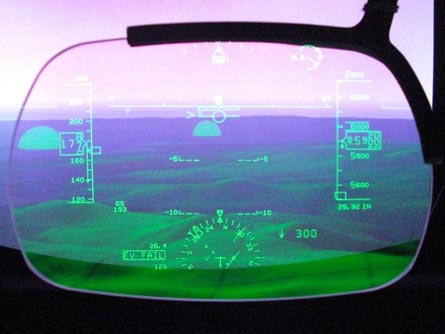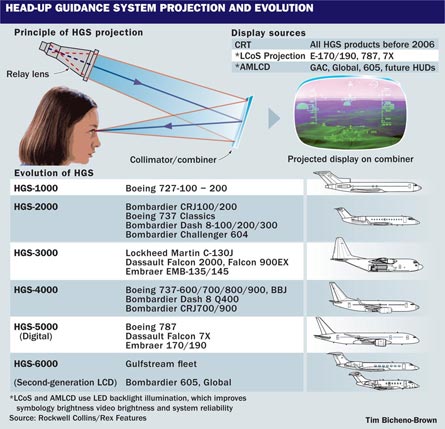Bob Carter, entrepreneur and founder of Flight Dynamics, developed the idea for the product now known as the Rockwell Collins head-up guidance system, after a close call when landing his twin-engined Cessna 310 in Portland's rainy, low-visibility weather in the late 1970s.
The weather in Portland today is still rainy for seven months of the year, but pilots by the thousands around the world have Carter's head-up display technology, now in its sixth generation, to help them fly safely.

Overall, Rockwell Collins, which purchased Flight Dynamics in 1998, has more than 3,300 HGS in service worldwide, certificated on 40 air transport (Part 25) category aircraft, including on a variety of executive jets built by Bombardier, Dassault, Gulfstream and Boeing.
In a just-published study by the Flight Safety Foundation, experts looked at almost 1,000 accidents from 1995 up to 2007 and surmised that today's HGS, particularly with its ability to show the flightpath vector and flightpath acceleration and velocity trends, would have helped avoid 38% of the prangs.
In early 2012 the HGS will take another evolutionary leap when Bombardier's Global Vision cockpit upgrade for the Global Express family of long-range business jets enters service with the Rockwell Collins HGS-6000 and a new feature. On the pilot's side-control yoke will be a switch that toggles between three flight guidance modes: standard HUD flight control symbology, enhanced vision using a CMC-built cooled infrared sensor, or synthetic vision (SVS). While there is nothing particularly new about the first two selections, the third option is newsworthy: Global Vision will be the first forward-fit application for a synthetic vision system on a HUD. The Global Vision flightdeck is based on Rockwell Collins Pro Line Fusion integrated avionics suite, which itself will include head-down synthetic vision on the 15.1in (385mm) primary flight displays.
HUD synthetic vision, which renders a 3D image of terrain, obstacles and runway information in multiple shades of green on the HUD combiner using a projection system overhead and visual data computed with on-board databases, will provide an immediate situational awareness boost to pilots.
In the longer term, Rockwell Collins through its work with RTCA, a consensus-based government-industry group that develops performance and operational standards, is hoping to enable regulations to allow "credit" for lowered approach minimums using head-up synthetic vision.
RTCA's work is largely supporting the US Federal Aviation Administration's plan to boost airspace safety and capacity in the long term by introducing systems that provide for clear weather daytime situational awareness in all environments, allowing for the equivalent of zero-visibility (0ft/0km) operations.
The steps to achieve the goal began in earnest several years ago with the regulatory approval of reduced instrument flight rules landing and take-off minima using enhanced vision on a HUD. So-called for-credit enhanced flight vision systems (EFVS) are now available on large-cabin Gulfstream aircraft equipped with Honeywell HUDs and cooled cameras built by Kollsman, and on some Bombardier Global Express aircraft with a Thales HUD and CMC sensor.
Rockwell Collins is in the process of gathering data to gain FAA certification for several of its existing EFVS systems for "credit" to land with lower cloud heights and visibility, including the Boeing Business Jet, Bombardier Challenger 605 and the Dassault Falcon 7X.
Robert Wood, Rockwell Collins HGS director of engineering, says he is expecting to gain certification for 7X credit in June and possibly by later this summer for the Challenger 605. The company to date has gained 30 certifications, mostly in the airline sector, for operations using its HGS (without EFVS) to perform manual Category III operations in which a pilot can manually fly the aircraft to 50ft (15m) above touchdown using the HUD and special data processing and algorithms. Certifications also allow for making take-offs with as little as 90m runway visual range (RVR) visibility using the HGS.
Ultimately, Rockwell Collins and other manufacturers believe a fused solution - SVS for terrain, obstacles and runway information and visual, infrared or radar sensing for feedback on the real-time environment, will be needed for 0/0 operations. RTCA is planning to complete a minimum performance standards list, a first step in creating new regulations, for such a system by December 2011.
Meanwhile, RTCA is planning to develop minimum performance standards for SVS landing credit down to 100ft by December this year. Key players are split on whether SVS credit will be allowed for both head-up and head-down applications, with Rockwell Collins currently aiming its technologies towards head-up credit and Honeywell investing in a head-down solution for SVS and fused SVS/EFVS.
Rockwell Collins is also researching lower-cost options for the EFVS portion of a 0/0 system, devices that to date all feature costly cooled mid-wave infrared (MWIR) cameras.
"As LED lighting emerges and as the USA goes to high efficiency lighting, it's going to make existing MWIR cameras challenged," says Wood. "We've done Sabreliner flight tests where we've looked at several technologies, comparing [uncooled] long-wave IR (LWIR) to MWIR in cold temperatures. It does seem to bear out that LWIR works better." Because they are uncooled, LWIR cameras are generally much less expensive than MWIR cameras.
Flight International previewed the HGS-6000 with synthetic vision at the Rockwell Collins' Portland facility in March, using a fixed-base large aircraft cockpit emulator and a Microsoft flight simulator-based visual system. The HGS-6000 set-up on the pilot's side location has a dual redundant input/output (I/0) subsystem with a five different video interfaces and a graphics card built around a custom Rockwell ASIC, all fitting in a 4 MCU processor box.
The projector in the HGS-6000 is of active-matrix LCD (AMLCD) technology with LED backlighting that is 20% lighter and 18cm shorter than the previous generation of liquid crystal on silicon-based projectors in the HGS-5000. The combiner gives a conformal view of the outside world, with 1,400 x 1,050 pixels covering a horizontal range of 42e_SDgr and vertical swath of 30e_SDgr. The AMLCD also offers greater brightness than previous units, a key feature for using SVS and EVS in daylight. The combiner typically displays six to eight shades of green in normal conditions, but even with ambient brightness of 10,000ft-Lambert, the intensity of sunlit clouds, it continues to show four shades of green, keeping critical symbology clear.
During our simulated approaches to the Portland area, the synthetic vision domes drawn over the airports along with extended runway centrelines made for quick identification of the intended destination and obstacle symbology clearly revealed threats greater than 200ft above the ground and terrain awareness alerts, revealing terrain threats as brighter than other terrain, performed as intended by drawing attention.
Wood says prototype HGS SVS software is being demonstrated in an aircraft, and flight testing is due to begin later this summer. The company plans to certificate the SVS as part of the Fusion flightdeck in spring 2011.
DOUBLE GLOBAL VISION IN TEST PROGRAMME
The second of four pre-production Global Vision test aircraft, a Global Express XRS, joined the first green test aircraft, also an XRS, at Bombardier's flight test facility in Wichita after first flight in late February. The aircraft will later receive its interior completion and become a demonstrator aircraft. The Global Vision update is largely built around the new Rockwell Collins flightdeck, based on the Proline Fusion architecture.
 |
|---|
Aircraft number one has accumulated 166 flight hours on 54 missions since first flight in August. Two more aircraft, both Global 5000s, will eventually complement the two XRS test aircraft. The first 5000 is slated to make its maiden flight in May. The fourth aircraft is on the assembly line in Toronto now, says Bassam Sabbagh, vice president and general manager of the Global family of aircraft for Bombardier.
The airframer is also testing the standard equipment captain-side Rockwell Collins head-up guidance system (HGS) on an existing Global 5000 to speed up the certification process, slated for Q1 2011. Entry into service (EIS) for the Global Vision upgrade is set for Q1 2012.
Sabbagh says Bombardier is currently working the integration of the enhanced vision system with the HGS on the Global 5000. The EVS uses a CMC-built cooled sensor. Bombardier plans to offer reduced approach minimums with the EVS at EIS, along with synthetic vision on the HUD and on the head-down displays.
BAE BETS ON Q-SIGHT FOR SMALL COCKPITS
BAE SYSTEMS is betting that small size is a good thing when it comes to head-up displays. The company's new Q-Sight low-cost HUD could allow for the safety enhancing technology to make its way into cockpits that are too small for bulkier traditional projector/combiner systems.
Q-Sight is a monocle that attaches to a pilot's headset, placing a transparent screen in front of the right eye for displaying flight parameters using holographic waveguides to move light from a 768 x 768 pixel liquid crystal display to a credit card-sized combining lens, eliminating the need for intermediate lenses. Aside from "one-off" sales, the UK Royal Navy is the first customer for the technology to help door gunners on the Westland Lynx Mk8 helicopter.
MORE
- Further safety improvements available with head-up guidance systems
- As theCroft Flies: Rockwell Collins HUD synthetic vision: Hold Your Head Up
Source: Flight International

















